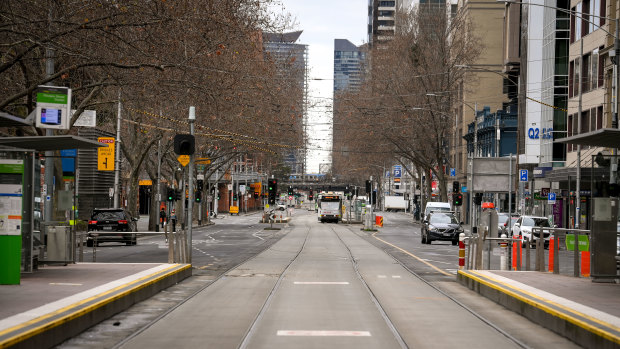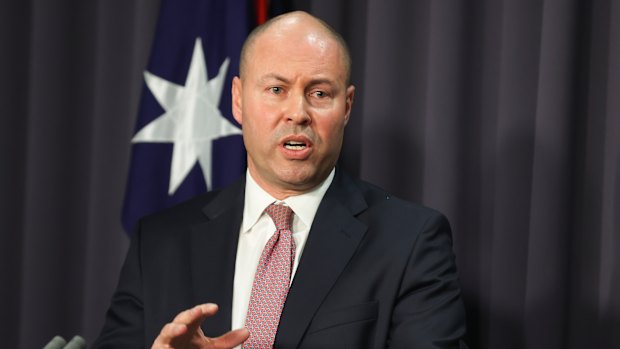This was published 3 years ago
War chest bounce: Treasurer expects COVID-19 hit to be cushioned by cash
By Shane Wright
Treasurer Josh Frydenberg has warned the economy could contract by more than 2 per cent through the September quarter due to lockdowns hitting NSW, Victoria and the ACT as job figures point to future pain for those looking to hold on to work.
But Mr Frydenberg said there would be an economic bounce back due to a $290 billion war chest of cash sitting in the bank accounts of businesses and consumers that would be unleashed once lockdowns ended.

Lockdowns like those in Melbourne are tipped by Treasurer Josh Frydenberg to knock GDP by at least 2 per cent in the September quarter.Credit: Eddie Jim
The Reserve Bank, Treasury and private sector economists are expecting the September quarter national accounts – which will be released in early December – to show a sharp fall in economic activity over the past three months. There are also fears about how the December quarter result could be affected.
Partial indicators already point to a sharp fall in household consumption of services while restrictions on businesses, particularly the NSW construction sector, have also hurt the broader economy.
Mr Frydenberg said at this stage it appeared the hit to GDP would be at least 2 per cent in the quarter.
A decline of that magnitude would be the second-worst quarterly performance on record. Only the 7 per cent drop in last year’s June quarter, caused by the nationwide lockdown to stop the spread of COVID-19, would be worse.
The Treasurer said despite the lockdowns, consumer confidence had held up, spending was higher than during last year’s shutdown period while business investment was being supported by low interest rates and government policies. Once the government’s vaccination targets were reached and states came out of lockdown, the economy would quickly recover.
“There’s some $290 billion that’s been accumulated on household and business balance sheets, today, that was not there at the start of the pandemic last year,” he said.
“What that means is that money gets built up to be able to be spent.”
July job figures from the Australian Bureau of Statistics highlighted the difficulty tracking the true state of the economy.
The nation’s jobless rate fell by 0.3 percentage points to 4.6 per cent, its lowest level in 13 years despite the creation of just 2200 extra jobs through the month. The participation rate fell by 0.2 percentage points while under-employment increased to 8.3 per cent.

Federal Treasurer Josh Frydenberg says businesses and households are sitting on a $290 billion war chest of cash.Credit: Alex Ellinghausen
According to the bureau, NSW’s jobless rate fell by 0.6 percentage points to 4.5 per cent, its lowest level since before the pandemic.
But total employment across the state fell by 36,400, there was a 64,000 drop in the size of the workforce and the number of people working zero hours jumped to 467,900 from 97,600 in June. The state’s effective unemployment rate, considering the drop in participation and hours, was 8.3 per cent.
The survey was taken in early July, when NSW was hopeful of coming out of lockdown by the end of the month. Instead, it was extended while the lockdown has been tightened and broadened to the rest of the state.
By contrast in Victoria, which came out of restrictions, the jobless rate was steady in July at 4.5 per cent but the under-employment rate grew by 1.9 percentage points to 8.2 per cent and total employment grew by 0.5 per cent. This will turn around in the August result as Victoria’s most recent lockdown is taken into account.
There are positive signs outside of Victoria and NSW. In WA, the jobless rate fell half a percentage point to 4.6 per cent, its lowest level since early 2013. The number of full-time jobs in the state also climbed to its highest level since the early 2010s mining construction boom.
EY chief economist Jo Masters said the real impact of lockdowns on the jobs market would soon become clear.
“The picture in August and September will look much different; while businesses are likely to try and adjust through hours worked, we expect jobs losses alongside rises in the unemployment and under-employment rates,” she said.